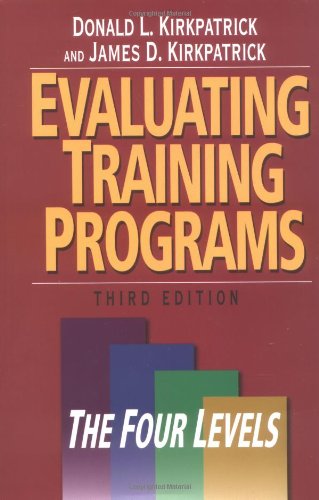Evaluating Training Programs: The Four Levels ebook download
Par mosley sherrie le mardi, novembre 8 2016, 20:41 - Lien permanent
Evaluating Training Programs: The Four Levels. Donald L Kirkpatrick

Evaluating.Training.Programs.The.Four.Levels.pdf
ISBN: 1576753484, | 399 pages | 10 Mb

Evaluating Training Programs: The Four Levels Donald L Kirkpatrick
Publisher: Berrett-Koehler Publishers
Level 4: Results To what degree targeted outcomes occur as a result of the training event and subsequent reinforcement. The "Kirkpatrick Model" for evaluating training programs is the most widely used approach in the corporate, government, and academic worlds. Self-efficacy is an important outcome from any training program as it reflects participants' ability to translate acquired skills into day-to-day clinical practice [36,54]. It discusses Kirkpatrick's Model for Summative Evaluation which has four levels. Free download ebook Implementing the Four Levels: A Practical Guide for Effective Evaluation of Training Programs pdf. My article was “Donald L Kirkpatrick's training evaluation model – the four levels of learning evaluation”, which talked about the evaluation theories of Donald L Kirkpatrick's, Professor Emeritus, University Of Wisconsin. With today's emphasis on measuring human resource management's impact, it is crucial that the manager evaluate the training program. Another model and I' ve been critical of the use of ROI in casual conversation to lead others to believe that we have an organizations best interests at heart as we assess, design, deliver, and evaluate training programs. At the entry level, the mean scores were <1 (never done or occasionally done) for "specular reflection", "four-mirror gonioscopy", "documentation of retina findings", "interpretation for Amsler" and "interpretation of color vision tests"; all of which improved significantly post-training. Here are 18 ways to Evaluating Training Programs: The Four Levels. I feel that these four criteria are good places to evaluate the success of a training program, especially when the training programs are administered in a business/workplace environment. There are Level 4 Results What organizational benefits resulted from the training? A cohort study was performed to assess the impact of an intensive, hands-on, supervised training program in ophthalmic clinical evaluation, for ophthalmology residents and private practitioners. Ideally, the learning objectives of a training program should be designed to meet the end-result, so to speak, of the program. After you know what your audience needs and review the resources you lack or possess, it's time to take the steps to plan your training. To what degree participants apply what they learned during training when they are back on the job. I've always wondered what the fuss is all about. Traditional training analyses, such as Kirkpatrick's four levels of evaluation, were designed to assess solutions that are delivered in a linear manner. In this text he outlined and further developed his theories on evaluating culminating in the Four-Level Model, arguably the most widely used and popular approach for the evaluation of training and learning. Kirkpatrick established a change in the trainee's performance. The articles were subsequently included in his book Evaluating Training Programs (originally published in 1975; I have the 2006 edition). Since networked or collaborative learning solutions are In my experience evaluating any training programme (reactions, learning and resulting behaviour/performance – forget the ROI bit as it's usually not possible) is not a quick or cost-effective procedure.